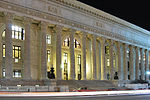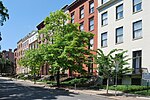New York State Association of Independent Schools
The New York State Association of Independent Schools (NYSAIS) is an association of 201 independent schools and organizations, ranging from nurseries to high schools, in New York State. Founded in 1947, NYSAIS is the second largest state association of independent schools in the United States. As of July 1, 2019 its member schools enrolled approximately 83,024 students. It was established "to protect independent schools from obstructive legislation and regulation". NYSAIS accredits member schools, provides professional development, and works with community leaders to support the needs and interests of independent schools throughout the state. NYSAIS is a member of the National Association of Independent Schools (NAIS) as well the International Council Advancing Independent School Accreditation (ICAISA).
Excerpt from the Wikipedia article New York State Association of Independent Schools (License: CC BY-SA 3.0, Authors).New York State Association of Independent Schools
Elk Street, City of Albany
Geographical coordinates (GPS) Address Nearby Places Show on map
Geographical coordinates (GPS)
| Latitude | Longitude |
|---|---|
| N 42.653586 ° | E -73.754782 ° |
Address
Elk Street
12210 City of Albany
New York, United States
Open on Google Maps











